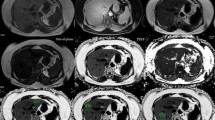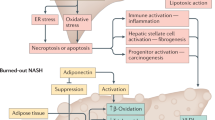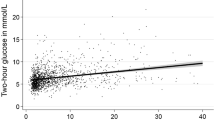Abstract
OBJECTIVE: To validate a variation of a well-established magnetic resonance imaging (MRI) technique to detect liver fat and use it to monitor liver fat changes after treatment with dexfenfluramine in men with non-insulin dependent diabetes mellitus (NIDDM). DESIGN: (a) Simple correlation study of MRI Liver Fat Index with liver biopsy results; (b) Open Study of 10 men with NIDDM treated with dexfenfluramine for 12 weeks in addition to their ‘usual’ therapy. SUBJECTS: (a) 19 patients (3F; 16M) with abnormal liver function tests undergoing liver biopsy; (b) 10 men, Body Mass Index (BMI) <30, Waist to hip ratio (WHR) >0.90 with poorly controlled NIDDM despite oral sulphonylurea therapy. MEASUREMENTS: (a) MRI liver fat; standard liver biopsy; (b) MRI visceral fat, MRI liver fat, euglycaemic clamp, plasma lipids, fasting glucose and c-peptide levels. RESULTS: In the validation group, there was a strong relationship between the MRI Liver Fat Index and histopathological assessment of the liver biopsies (r=0.87, <0.0001). During treatment with dexfenfluramine the mean Liver Fat Index reduced from 10.6±3.4 to 6.6±2.8 (P=0.05). The reduction in Liver Fat Index correlated with the reduction in visceral fat (r=0.84, P=0.001) as well as with the improvement in insulin sensitivity (r=0.62, P=0.05). Using partial correlation analysis, the relationship between the change in visceral adipose tissue and the improvement in insulin sensitivity was weaker if the Liver Fat Index was kept constant (r=0.76 decreased to r=0.56). CONCLUSIONS: In this group of subjects MRI Liver Fat Index correlated well with liver fat as seen on biopsy. The Liver Fat Index reduced after 12 weeks therapy with dexfenfluramine suggesting a role for hepatic steatosis in the complex interaction between visceral adipose tissue and insulin sensitivity.
This is a preview of subscription content, access via your institution
Access options
Subscribe to this journal
Receive 12 print issues and online access
$259.00 per year
only $21.58 per issue
Buy this article
- Purchase on Springer Link
- Instant access to full article PDF
Prices may be subject to local taxes which are calculated during checkout
Similar content being viewed by others
Author information
Authors and Affiliations
Rights and permissions
About this article
Cite this article
Marks, S., Moore, N., Ryley, N. et al. Measurement of liver fat by MRI and its reduction by dexfenfluramine in NIDDM. Int J Obes 21, 274–279 (1997). https://doi.org/10.1038/sj.ijo.0800400
Received:
Revised:
Accepted:
Issue Date:
DOI: https://doi.org/10.1038/sj.ijo.0800400
Keywords
This article is cited by
-
Effect of Rosiglitazone on Insulin Sensitivity and Body Composition in Type 2 Diabetic Patients
Obesity Research (2002)



